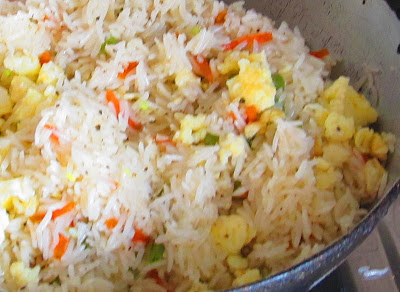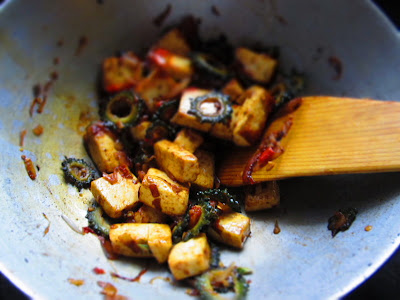When bored to death of daal-bhaat, drowned in work, and unable to even spare the time to take a walk to the closest take-away, fried rice is deliverance. If I have to wax eloquent about this simple, austere, yet utterly delightful dish, tastebuds are wasted on you.
This dish saved my life today, after a lizard scurried over my toe and made me spill the leftovers I was saving for brunch all over the floor. After the tedious, tedious clean-up in the thick, soupy mid-morning heat, I considered my sweat-blurred vision and the rivulets racing down my skin, and chucked all idea of a greasy, over-spiced take-away. The idea of cooking was not attractive either, but I love my rice, and if I had to endure ten minutes in the kitchen for divine, mildly-flavoured rice, by gods, I would do it!
And that is the genesis of this dish :-) Picturebook below:
If you're not an expert at draining pots of cooked rice, use this method: Scoop rice out onto the middle of a large piece of cheesecloth, or the sort of kitchen-net one covers the mouths of pots and pans with to keep crawlies out. Loosely tie the ends of the cloth/net together to make a potla/potli/tear-drop shaped satchel. Hold it under a running tap and rustle to get the starch out of the rice and vegetables. After a minute of this washing, tighten the knot and hang it like you would hang curd. Walk away and sit under the fan for twenty minutes while all the water drips out of the rice.
Now that I'm done, I realised it took me longer to write the post than it took me to make the dish. Give it a try!
This dish saved my life today, after a lizard scurried over my toe and made me spill the leftovers I was saving for brunch all over the floor. After the tedious, tedious clean-up in the thick, soupy mid-morning heat, I considered my sweat-blurred vision and the rivulets racing down my skin, and chucked all idea of a greasy, over-spiced take-away. The idea of cooking was not attractive either, but I love my rice, and if I had to endure ten minutes in the kitchen for divine, mildly-flavoured rice, by gods, I would do it!
And that is the genesis of this dish :-) Picturebook below:
Boil rice, chopped carrots and beans till tender -- but not mushy! -- in your usual vessel. Drain the starchy water.
If you're not an expert at draining pots of cooked rice, use this method: Scoop rice out onto the middle of a large piece of cheesecloth, or the sort of kitchen-net one covers the mouths of pots and pans with to keep crawlies out. Loosely tie the ends of the cloth/net together to make a potla/potli/tear-drop shaped satchel. Hold it under a running tap and rustle to get the starch out of the rice and vegetables. After a minute of this washing, tighten the knot and hang it like you would hang curd. Walk away and sit under the fan for twenty minutes while all the water drips out of the rice.
This is what properly-drained rice looks like.
Now, in a wok, add about three tablespoons of oil. Trust me on this. Beat together two eggs, a tablespoon of milk, and two pinches of salt. When fluffy, pour into the wok and attack with a spatula till the eggs scramble and are cooked thoroughly -- not a like a soft breakfast scramble, but all the way through. Keep this aside.
Now, in a larger wok, heat about a tablespoon of oil, and grease the sides of it very well. When the oil starts bubbling, turn down the flame and add the now-drained rice and veggies into this. Give it a few quick stirs to make sure nothing sticks to the sides or the bottom of the work. Then sprinkle quarter teaspoon salt, half teaspoon sugar (yes, sugar), one teaspoon crushed black pepper. Keeping the flame low, hold the wok steady and stir continuously till the rice and veggies look and smell deliciously fried. If you want that 'restaurant flavour', you can add three pinches of ajinamoto/MSG crystals, but I advise against it. Try half a teaspoon of soya sauce instead.
Now, pour the scrambled eggs onto the rice.
Mix it up!
Serve :-)
Now that I'm done, I realised it took me longer to write the post than it took me to make the dish. Give it a try!






























